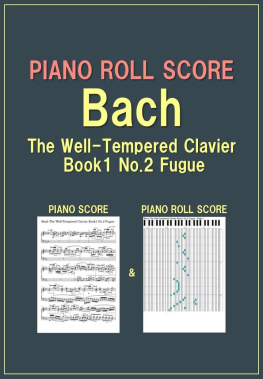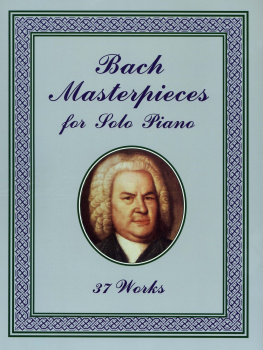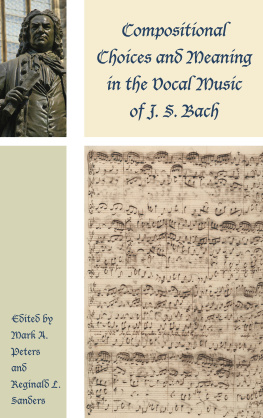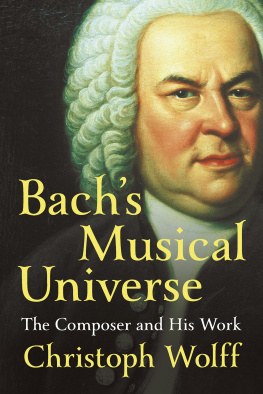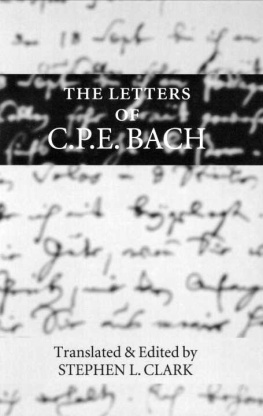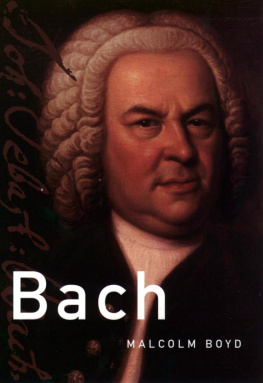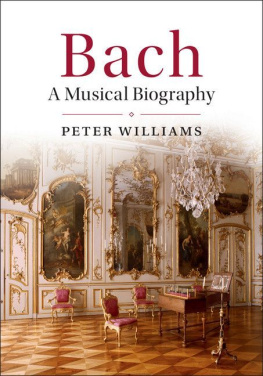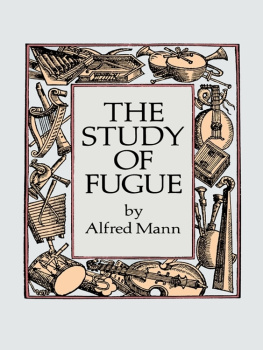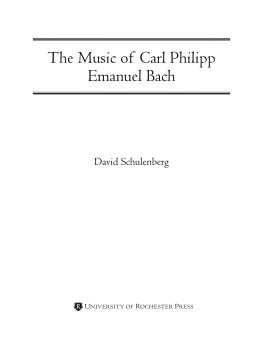Rethinking J.S. Bachs The Art of Fugue
The enigmatic character of The Art of Fugue became apparent as early as in its first edition, printed more than a year after the composers death. Carl Philipp Emanuel Bach, who published both the first and second editions, raised several unsolved questions regarding this opus. Anatoly P. Milka presents a consistent and coherent solution to the unresolved questions about the history, structure and appearance of J.S. Bachs The Art of Fugue, opening new perspectives for further exploration of this musical masterpiece. Milka challenges the present scholarly consensus that there are two different versions of The Art of Fugue (the Autograph and the Original Edition) and argues that Bach had considered four versions, of which only two are apparent and have been discussed so far. Only Bachs illness and death prevented him from fulfilling his plan and publishing a fourth, conclusive version of his opus.
Anatoly P. Milka is Professor and Dr Habil of Musicology at the St Petersburg Conservatory and the St Petersburg State University, Russia. His publications in Russian include Theoretical Foundations of Functionality in Music (St Petersburg, 1982); Bachs Musical Offering: Toward Reconstruction and Interpretation (Moscow, 1999); Intriguing Bachiana (with Tatiana Shabalina; St Petersburg, 1997, 2001); a facsimile edition of LA.B.C. Musical von Gottfried Kirchhoff (St Petersburg, 2004), and Bachs The Art of Fugue: Toward Reconstruction and Interpretation (St Petersburg, 2009). This is his first book appearing in English.
Marina Ritzarev is Professor and Dr Habil of Musicology. She was a student and scholar in St Petersburg and Moscow before moving to Israel in 1990, where she teaches at Bar-Ilan University. She has authored books in Russian on Dmitry Bortniansky (1979, 2015), Maxim Berezovsky (1983, 2013), Sergei Slonimsky (1991) and the Russian Sacred Concerto (2006). Her two books in English Eighteenth-Century Russian Music (2006) and Tchaikovskys Pathtique and Russian Culture (2014) were published by Ashgate.
Esti Sheinberg is Associate Professor of Practice in Music History at the Glenn Korff School of Music, University of Nebraska-Lincoln, USA (BA in musicology at the University of Tel-Aviv, Israel; PhD in music at the University of Edinburgh, UK). She has authored Irony, Satire, Parody and the Grotesque in the Music of Shostakovich (Ashgate, 2000) and edited Music Semiotics: A Network of Significationsin Honour and Memory of Raymond Monelle (Ashgate, 2012).
First published 2017
by Routledge
2 Park Square, Milton Park, Abingdon, Oxon OX14 4RN
and by Routledge
711 Third Avenue, New York, NY 10017
Routledge is an imprint of the Taylor & Francis Group, an informa business
2017 Anatoly Milka
The right of Anatoly Milka to be identified as author of this work has been asserted by him in accordance with sections 77 and 78 of the Copyright, Designs and Patents Act 1988.
All rights reserved. No part of this book may be reprinted or reproduced or utilised in any form or by any electronic, mechanical, or other means, now known or hereafter invented, including photocopying and recording, or in any information storage or retrieval system, without permission in writing from the publishers.
Trademark notice: Product or corporate names may be trademarks or registered trademarks, and are used only for identification and explanation without intent to infringe.
British Library Cataloguing in Publication Data
A catalogue record for this book is available from the British Library
Library of Congress Cataloging in Publication Data
Names: Milka, A., 1939 (Anatoly Pavlovich) | Ritzarev, Marina, 1946 translator | Sheinberg, Esti, 1954 editor
Title: Rethinking J.S. Bachs the Art of fugue / by Anatoly P. Milka; translated by Marina Ritzarev; edited by Esti Sheinberg.
Other titles: Iskusstvo fugi I.S. Bakha. English Description: 2016. | Includes bibliographical references and index.
Identifiers: LCCN 2015045559 (print) | LCCN 2015046922 (ebook) | ISBN 9781472458865 (hardcover: alk. paper) | ISBN 9781315606095 (ebook) | ISBN 9781472458889 (epub)
Subjects: LCSH: Bach, Johann Sebastian, 16851750. Kunst der Fuge.
Classification: LCC ML410.B13 M5313 2016 (print) | LCC ML410.B13 (ebook) | DDC 786/.1872dc23
LC record available at http://lccn.loc.gov/2015045559
ISBN: 9781472458865 (hbk)
ISBN: 9781315606095 (ebk)
Bach musicological font developed by Yo Tomita
Typeset in Perpetua
by codeMantra
For the blessed memory of my friend Valery Maisky
Unless otherwise specified, all figures listed here are defined as public domain.
| BD | Bach-Dokumente, Hrsg. v. Bach-Archive Leipzig (Supplement zu: Johann Sebastian Bach Neue Ausgabe smtlicher Werke): |
| BD I | Schriftstcke von der Hand Johann Sebastian Bachs. Kritische Gesamtausgabe, eds. Werner Neumann and Hans-Joachim Schulze (Kassel: Brenreiter; Leipzig: VEB Deutscher Verlag fr Musik, 1963) |
| BD II | Fremdschriftliche und gedruckte Dokumente zur Lebensgeschichte Johann Sebastian Bachs 16851750. Kritische Gesamtausgabe, eds. Werner Neumann and Hans-Joachim Schulze (Kassel: Brenreiter; Leipzig: VEB Deutscher Verlag fr Musik, 1969) |
| BD III | Dokumente zum Nachwirken Johann Sebastian Bachs, 17501800, ed. Hans-Joachim Schulze (Kassel: Brenreiter; Leipzig: VEB Deutscher Verlag fr Musik, 1972) |
| BD V | Dokumente zu Leben, Werk, Nachwirken Johann Sebastian Bachs, 16851800, eds. Hans-Joachim Schulze and Andreas Glckner (Kassel: Brenreiter, 2007). |
| BJ | Bach-Jahrbuch (1904) |
| BWV | Alfred Drr, Yoshitake Kobayashi and Kirsten Beiwenger (eds.), Bach-Werke-Verzeichnis: Kleine Ausgabe (BWV2a), nach der von Wolfgang Schmieder vorgelegten 2. Ausgabe (Wiesbaden, 1998) |
| Cp | Contrapunctus [a fugue as designated in the Original Edition] followed by its serial number. As the Original Edition does not give the serial number after 12, numbers 13 and 14 are in square brackets. The fugue for two claviers and the final piece (Fuga a 3 Soggetti) are distinguished as Cp[14] and Cp[14F] respectively |
| KB | Kritischer Bericht (Critical commentary volumes) accompanying NBA: |
| II/1 | Friedrich Smend, Missa; Symbolum Nicenum; Sanctus; Ossana, Benedictus, Agnus Dei et Dona Nobis Pacem (spter genannt Messe in h-Moll) (Kassel, 1956) |
| IV/2 | Hans Klotz, Die Orgelchorle aus der Leipziger Originalhandschrift (Kassel, 1957) |
| IV/4 | Manfred Tessmer, Dritter Teil der Klavierbung (Kassel, 1974) |
| VIII/1 | Christoph Wolff, Kanons, Musikalisches Opfer (Kassel, 1976) |
| VIII/2 | Klaus Hofmann, Die Kunst der Fuge (Kassel, 1996) |
| MMB | [Mizlers Musikalische Bibliothek] Lorenz Christoph Mizler von Kolof, Neu erffnete musikalische Bibliothek, oder Grndliche Nachricht nebst unpartheyischem Urtheil von musikalischen Schriften und Bchern (Leipzig, 17361754) |
| NBA | [Neue Bach-Ausgabe: Complete edition of Bachs works] Johann Sebastian Bach, Neue Ausgabe smtlicher Werke (Kassel, 19542008) |
Next page

